ARTOIS - Neuville-St. Vaast - Souchez
Year of visit: 2008, 2014
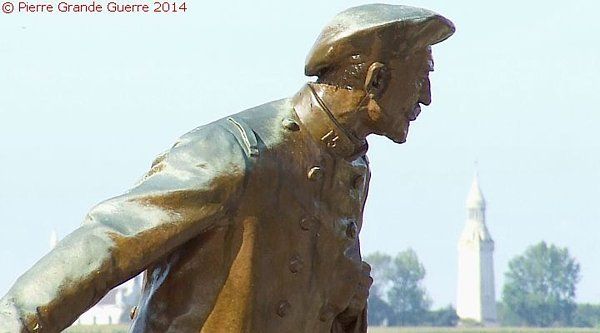
With some exceptions this route focuses on the Route de Béthune, the D 937, between Arras and Souchez. The Route de Béthune formed the axis of the battlefield of the Second and Third Battle of Artois. North of Arras and west of Ecurie we start this route on the D 49e1 with a visit to the Leuregans Monument standing on the former site of the “Labyrinth”, south of Neuville-St.Vaast. From there we continue our route via the D 937 with a visit to the “Neuville-St.Vaast Deutsche Kriegsgräberstätte”. Next we continue northward to the la Targette memorials, with a short detour westward to the hill of Mont St. Eloi. From there we return to la Targette to continue northward visiting the la Targette Czechoslovakian War Cemetery, the Polish War Memorial, the former location of the Cabaret Rouge tavern, the Cabaret Rouge British War Cemetery, and the General Sabot Memorial at Souchez. We finish this route at the foot of the hill of Notre Dame de Lorette, at the ruins of the St. Nazaire church in Ablain-St. Nazaire. In between I will explain briefly in several frames the background of these sites during the Second and Third Battle of Artois.
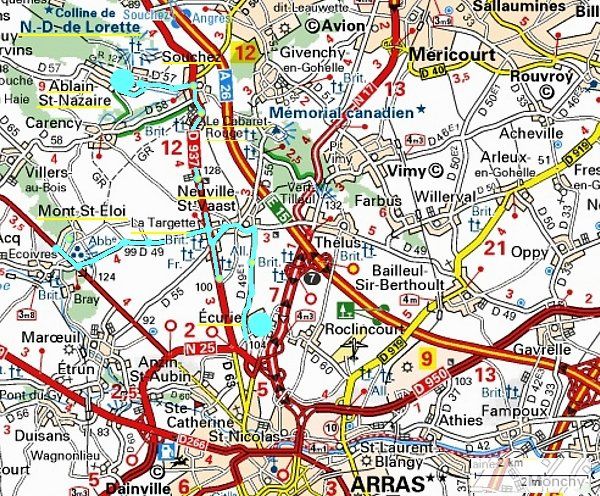
We start at the D 49e1, west of Ecurie, following the hollow road northward to Neuville-St. Vaast. After some 500 m. we enter the location of “The Labyrinth”.
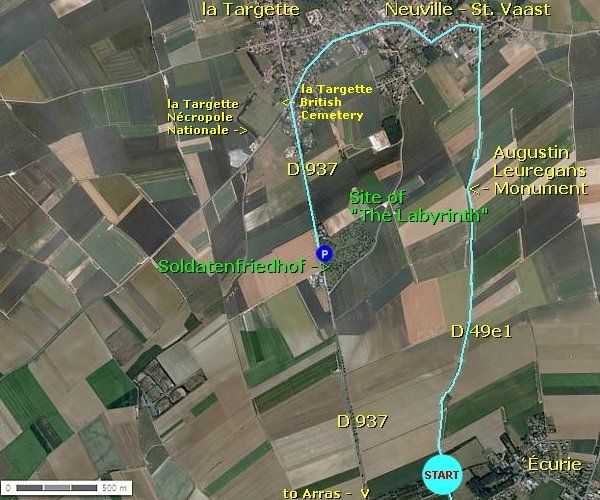
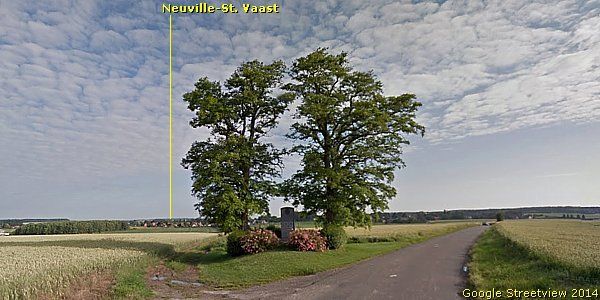
Some 500 m. farther we stop at a modest monument for a young war hero, Augustin Leuregans, with an interesting inscription.
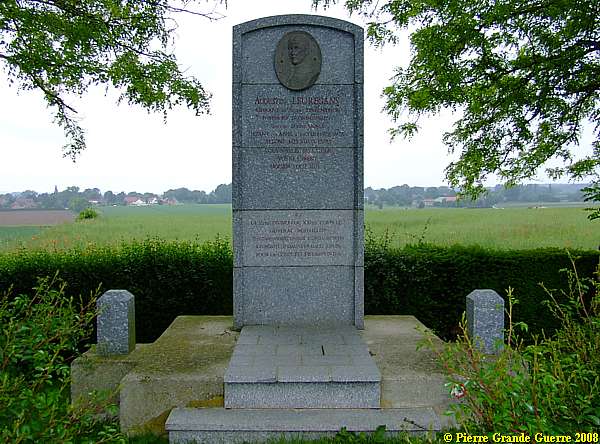

"AUGUSTIN LEUREGANS
JUNIOR of the 236th INFANTRY REGIMENT
FELL HERE GLORIOUSLY
in his 19th YEAR
WHILE CALLING THIS APPEAL TO HIS COUNTRYMEN
COME ON MY OLD DADDIES
YOU WILL NOT ALLOW
YOUR CHILD TO DIE ALL ALONE
HERE
THE 53RD DIVISION OF XX CORPS
OF GENERAL BERTHELOT
AND THE SUPERIOR COMMANDER GENERAL BALFOURIER
HAS FOUGHT ENERGETICALLY IN MAY AND JUNE 1915
FOR THE CONQUEST OF THE LABYRINTH "
In the intermezzo below I explain the background to this site of the memorial.
The Second Battle of Artois and "The Labyrinth"
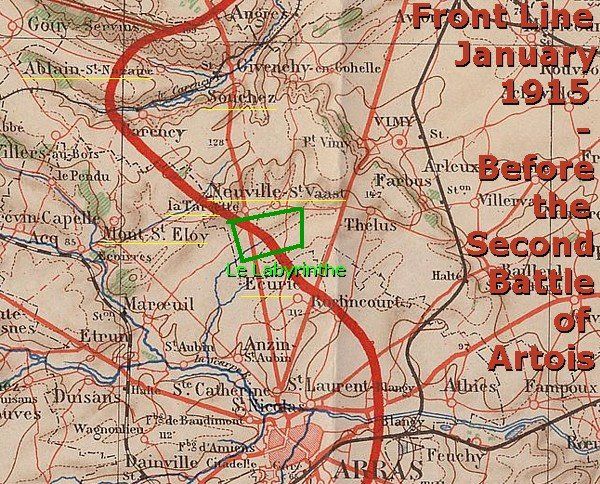
The Second Battle of Artois - 9 May - 18 June 1915
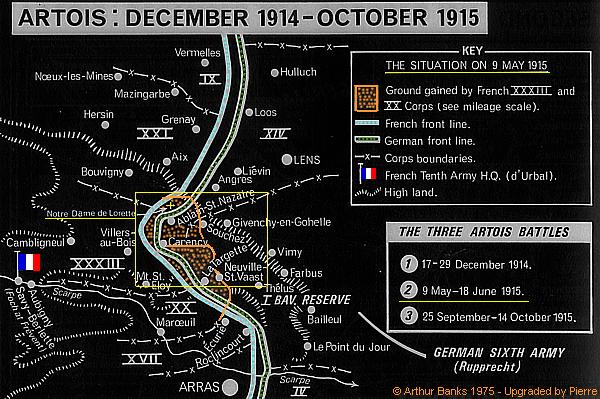
During the Great War there have been three Battles of Artois. This intermezzo focuses on the Second Battle of Artois and the French contribution to these battles.
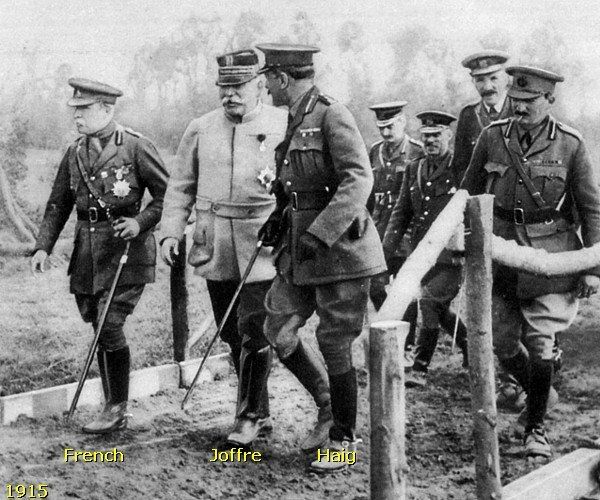
The French Commander-in-Chief, Général Joffre, requested support for his Artois offensive from British units under Field Marshal Sir John French, Commander of the British Expeditionary Force. On 9 May 1915 the British launched in their front sector, more to the north, a pincer attack on Festubert, Neuve Chapelle, and Aubers Ridge .
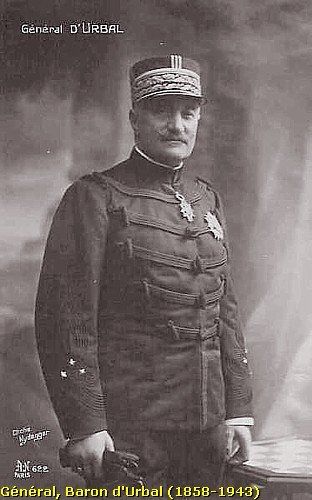
Five Army Corps of the 10th Army of Général d'Urbal launched an offensive at Notre Dame de Lorette , Neuville-St.Vaast and Vimy Ridge .
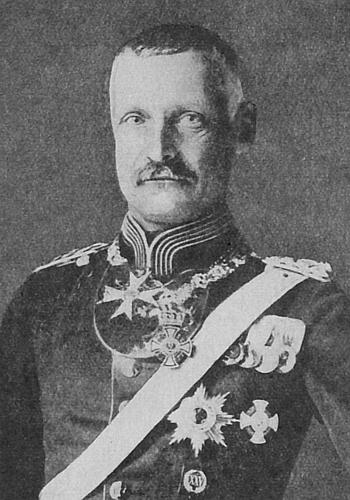
Crown Prince Rupprecht Von Bayern 's 6th Army defended this front sector. Remarkably: Rupprecht (1869-1955) was on average 15 years younger than the French generals.
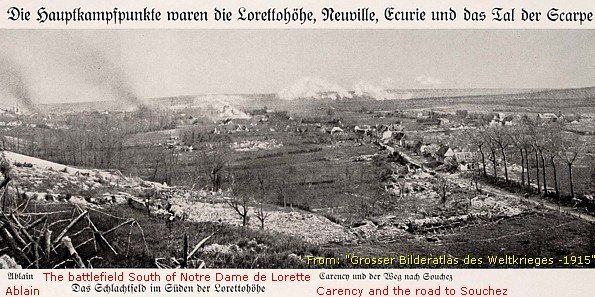
At 6.00 AM, the French artillery began a preliminary bombardment of 4 hours. After this bombardment the French infantry attacked. The German positions along the "Route de Béthune", the D 937, Notre Dame de Lorette Hill and Vimy Ridge were the main targets of the offensive.
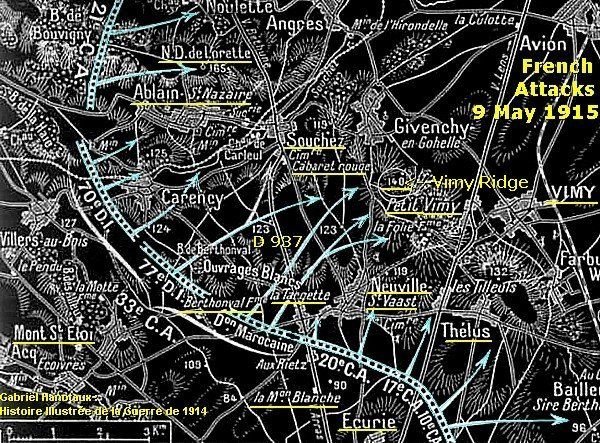
Géneral Pétain's XXXIII Army Corps made a fast progress in the sector between Souchez and Neuville-St. Vaast.
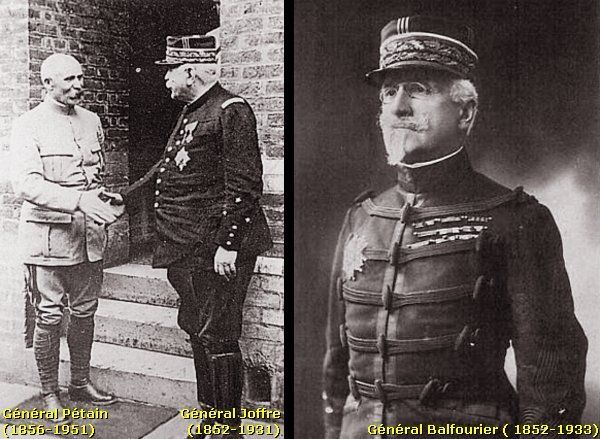
Général Balfourier's XX Army Corps attacked Neuville-St. Vaast.

The Moroccan Division, part of the XXXIII Corps, reached almost the upper heights of Vimy Ridge.
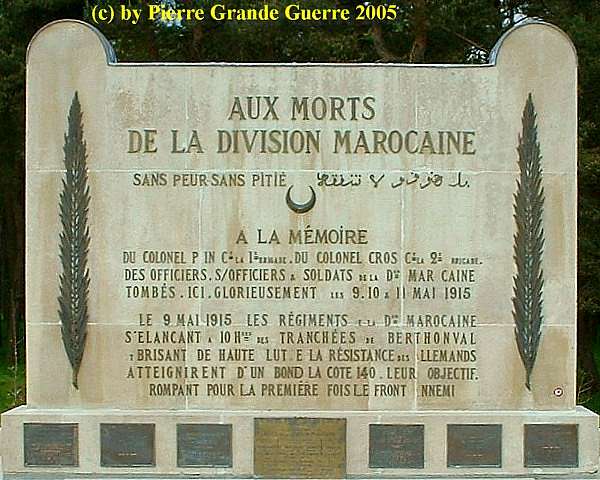
Pétain however had gone too fast and too far to the east, and his troops were pushed back by the 1st Bavarian Reserve Division.
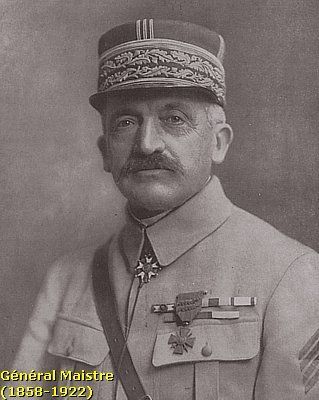
At Notre Dame de Lorette XXI Corps of Géneral Maistre attacked again upward the 165 m. high hill.
Maistre knew to conquer the summit of the hill at 12 May. But it would take another 10 days before the hill was cleared of Germans.

On 18 June 1915 the Second Battle of Artois came to an end. The French conquered Notre Dame de Lorette, Ablain-St. Nazaire, and Neuville-St. Vaast. A large part of Souchez and Vimy Ridge, however, including the surrounding lower levels, would stay in German possession until 9 April 1917.
"The Labyrinth"
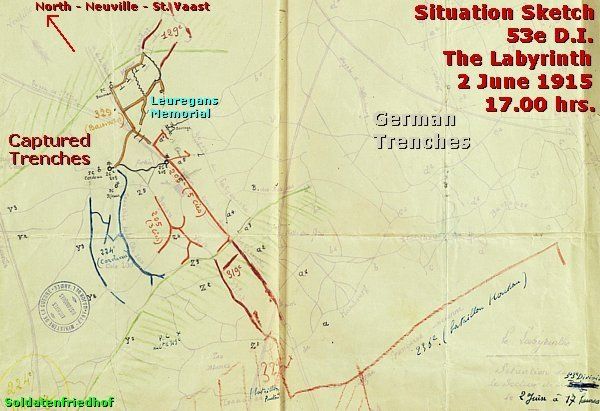
"The Labyrinth" was the French name for a German trench network south and south-west of Neuville-St Vaast. The Labyrinth was a maze of barbed wire obstacles, trenches, underground tunnels and dug-outs, all fortified with machine-gun posts.
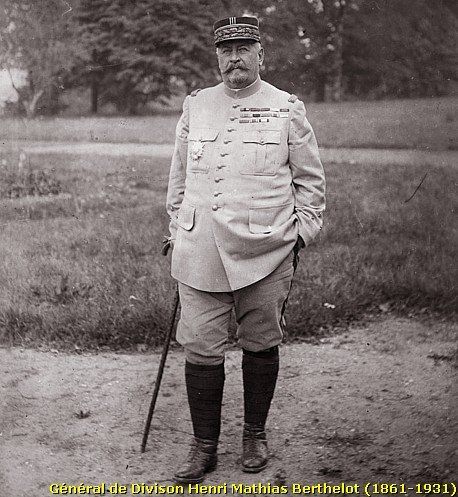
On the first day of the Second Battle of Artois, on 9 May 1915, Général Berthelot's 53rd Infantry Division of XX Corps attacked the Labyrinth.
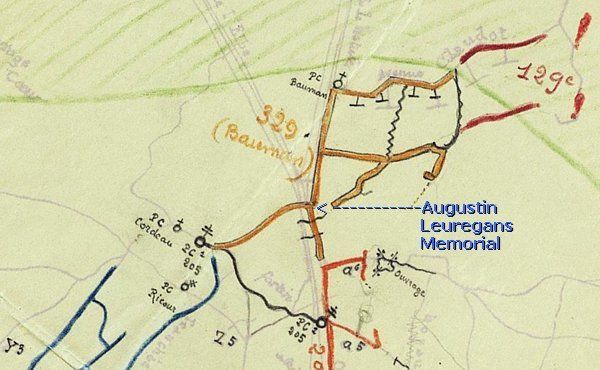
The situation of the Labyrinth during the day A. Leuregans fell
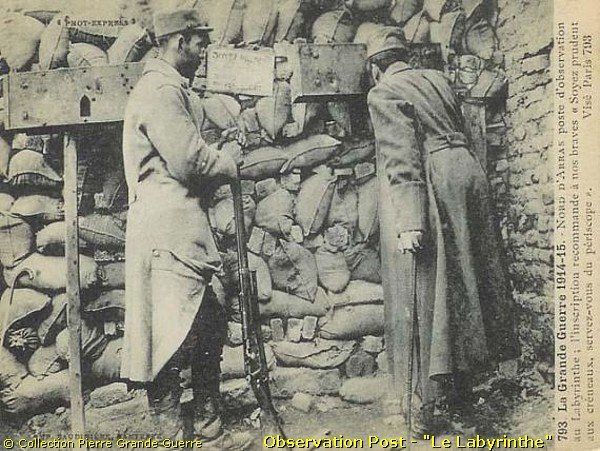
The day that the young Leuregans fell, 30 May 1915, was perhaps the bloodiest day for the 53rd Division during the 5 weeks of battle for the possession of the Labyrinth. On the 30th the 236th Infantry Regiment (236e R.I.) deployed its troops for a new attack on the Labyrinth.
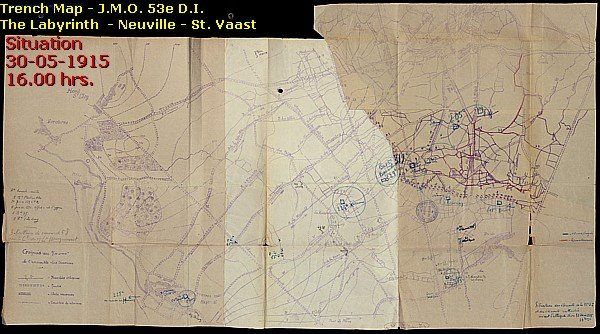
On its left flank the 319e R.I. attacked and on its right flank the 136e R.I. The main target of the attack was the German trenches of “Triangle Z”, between the road to Ecurie and the Route de Béthune, and the German trenches, called “Boyeau d'Haubourg” and “ Boyeau d'Eulembourg”.
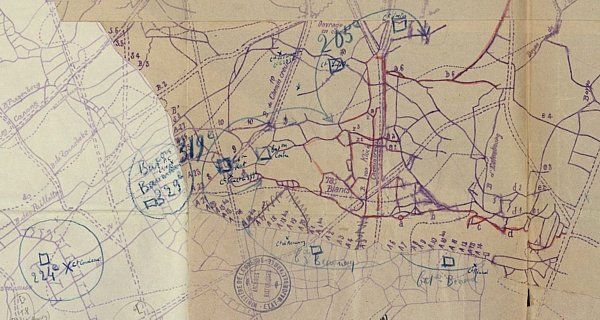
One of the centre points of the fights was a mine crater near Trench Z, which the 19th Company attacked. The 17th Company attacked Trench Z from trench A3, A4, and A5.
At about 16.00 hrs, the 21st and 24th Companies attacked the “Boyeau d’Eulembourg” or Trench C, east of the Ecurie-Neuville road. The companies “seemed to have reached the German barbed wire and perhaps the trenches”, but including all officers “none of them reappeared”.
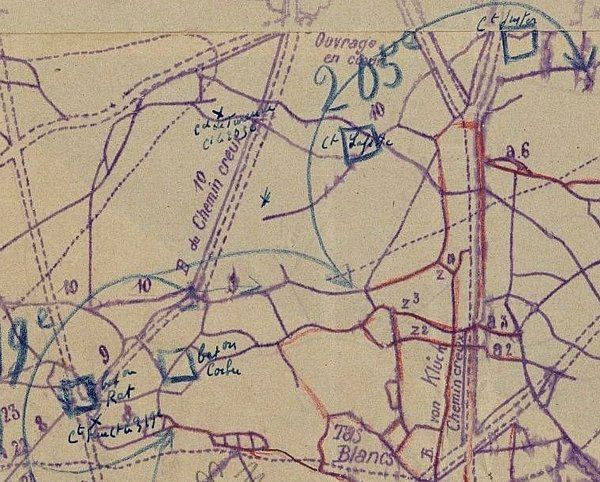
During the attack the 236 R.I. lost more men, a.o. 3 Captains, of whom two were mortally wounded, and one severely wounded.
To offer you a modest impression of these bloody fights I translated this fragment from the 4 and a half pages of the war diary of 30 May of the 236e R.I.:
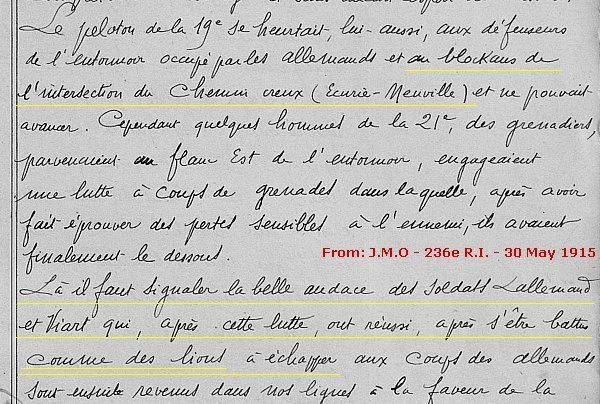
“The Platoon of the 19th, they too attacked the defenders of the mine crater, occupied by the Germans and the bunker on the crossroads of the hollow road Ecurie-Neuville and it could not advance. Simultaneously some men of the 21st (Company), grenadiers, arrived on the east side of the mine crater and engaged in fighting launching hand grenades, during which, after having experienced significant losses caused by the enemy, they succumbed.
Here should be noted the fine audacity of the German soldiers and (Company) Viart, who, after this fight, have succeeded, after having fought like lions, to escape the German fire and who have returned next to our lines thanks to the night and who have departed again on their own initiative to search for wounded men on the terrain.”
The Fate of Augustin Leuregans
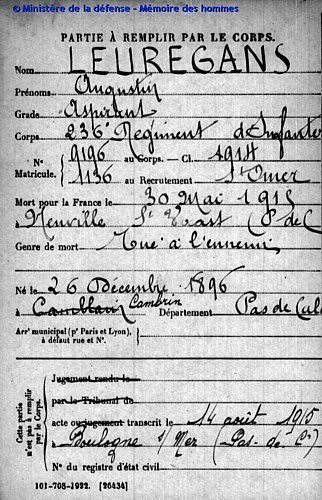
Being the commander of his section, mainly composed by older men of around 40 years old, the 19 year old Aspirant Officer Leuregans and his men were stuck in a semi-underground shelter under German fire. His older soldiers were reluctant to launch a counter-attack. To convince them to attack Leuregans turned to his men, speaking his last words: “COME ON, MY OLD DADDIES, YOU WILL NOT ALLOW YOUR CHILD TO DIE ALL ALONE!” After this appeal Leuregans was immediately killed. His act of bravery dissuaded his men from going on with the fight!
The Capture of the Labyrinth
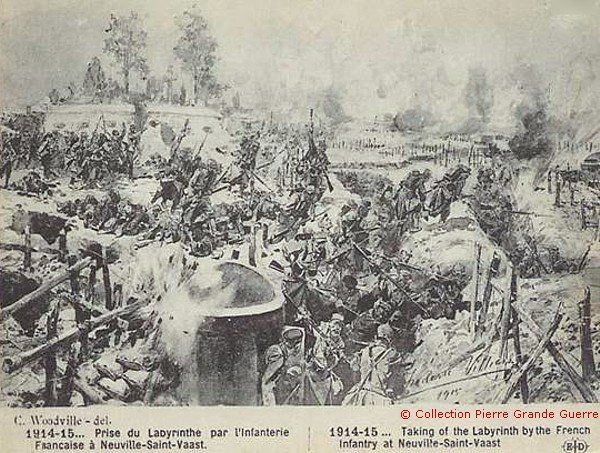
Finally, after a preliminary artillery bombardment of 300.000 shells the 53e D.I. captured the Labyrinth and the village of Neuville-St. Vaast on 17 June 1915. The Bavarians however still occupied a similar maze of trenches north and north-east of Neuville-St. Vaast.
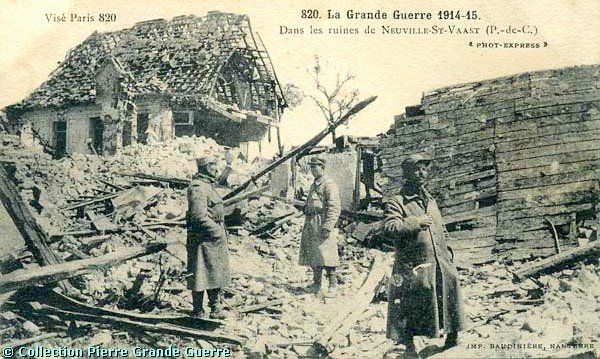
View from the Leuregans Memorial northward at the outskirts of Neuville-St. Vaast.
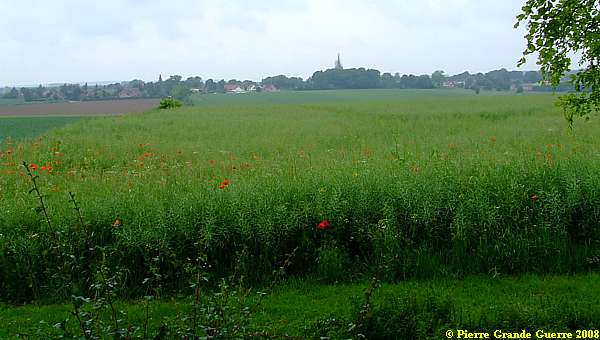
To avoid an unpaved road we make a short detour through the village of Neuville-St. Vaast, to continue south over the Route de Béthune, the D 937, passing the French and British war cemeteries on the west side of the road, to a location called Maison Blanche.

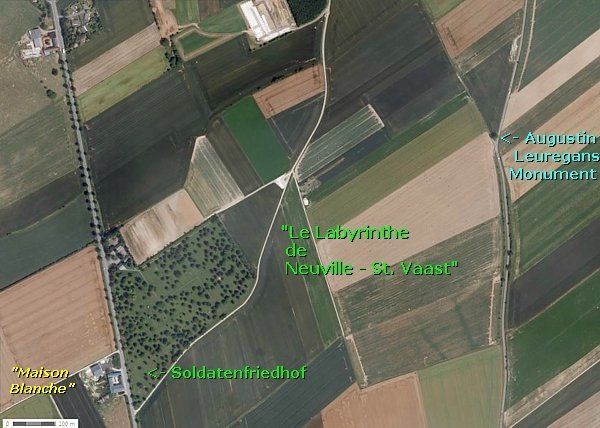
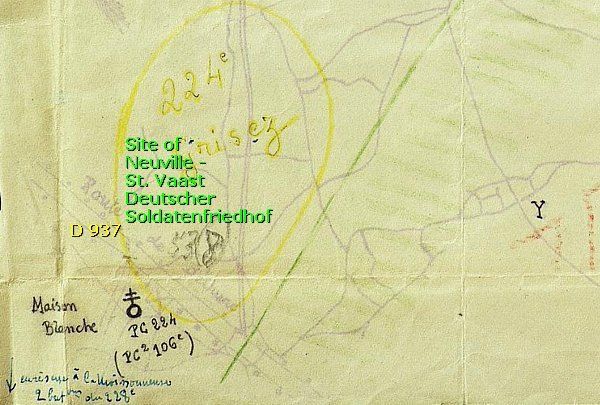
We stop for a visit to the largest German war cemetery of the Great War, the Deutsche Kriegsgräberstätte Neuville-St. Vaast .
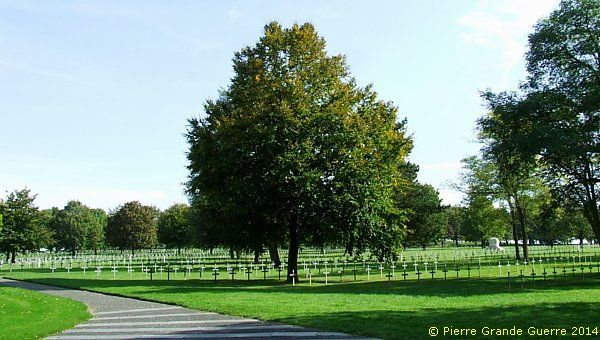
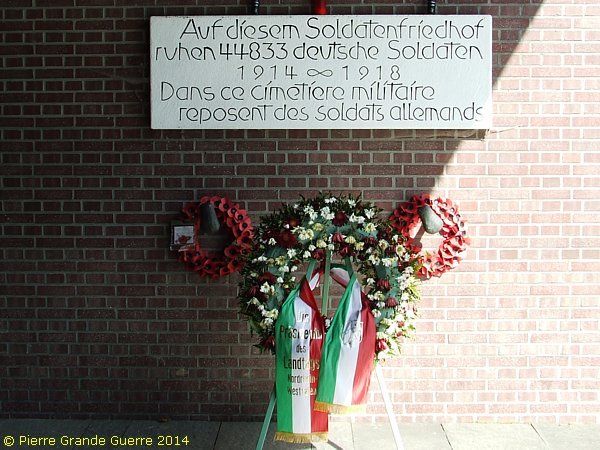
The Deutsche Kriegsgräberstätte Neuville-St. Vaast (also called La Maison Blanche, after a farm opposite the road) was built by the French military authorities in 1919 to 1923 as a collective cemetery for German war dead from the area north and east of Arras. It is the largest German military cemetery of the Great War in France! From more than 110 municipalities in the department of Calais the reburial was performed of the German dead who had hitherto been buried in field graves or in small cemeteries. A high number of remains were found over the years of clearing and re-cultivation of the former battlefield. Even in this day and age the dead are found during construction works, often in larger quantities such as during the construction of the A 26 motorway (Autoroute des Anglais) on the battlefield of Vimy Ridge. The French military authorities buried the majority of the found but unidentified dead in a large communal grave on the second major German military cemetery in the area of Arras, St. Laurent-Blangy. From the former cemetery in Boiry-Ste. Rictrude the authorities transported the monument to the fallen of the Hannover Infanterie Regiment 164 to Neuville-St. Vaast. The memorial was created during the war by serving German army sculptors and stonemasons. Today the men resting in the cemetery belonged to more than 100 different divisions of infantry and artillery regiments and many other units as pioneers, airmen, mortar launchers etc. The soldiers and officers, buried here, lost their lives during the heavy fighting around Artois and the hill of Notre Dame de Lorette during the period of August 1914 until the end of 1915, the Vimy Ridge Easter Battle of 1917, and in the autumn of 1918, as well as by the struggle of "normal" days of trench warfare. The troops involved were from all countries and provinces of the former German Reich.
588 Of the 36,848 dead in individual graves remain unknown. 8,040 Fallen rest in a communal grave. The 842 names of fallen soldiers buried in the communal grave are mentioned on metal panels.
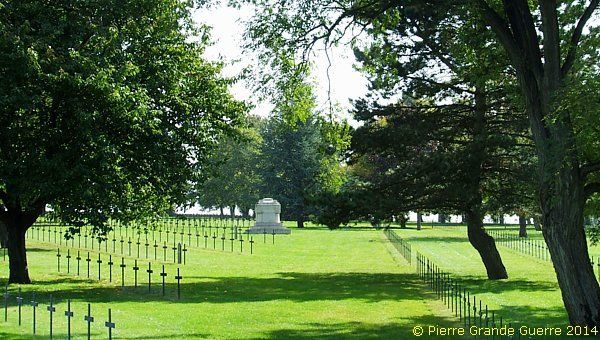
The memorial of the Hannover Infanterie Regiment 164.
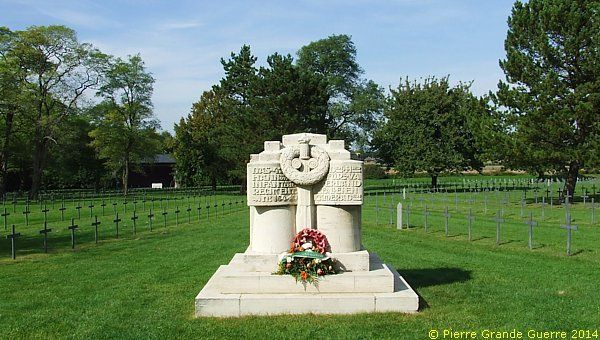
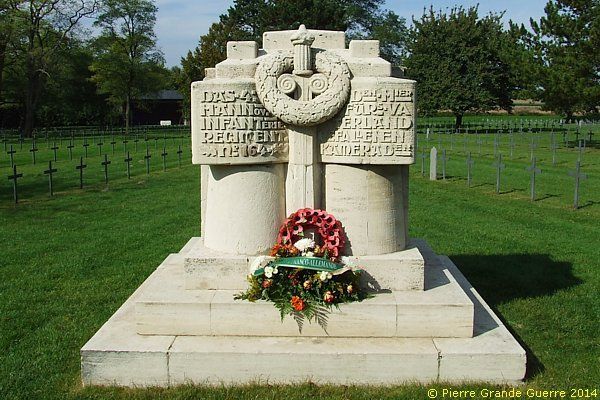
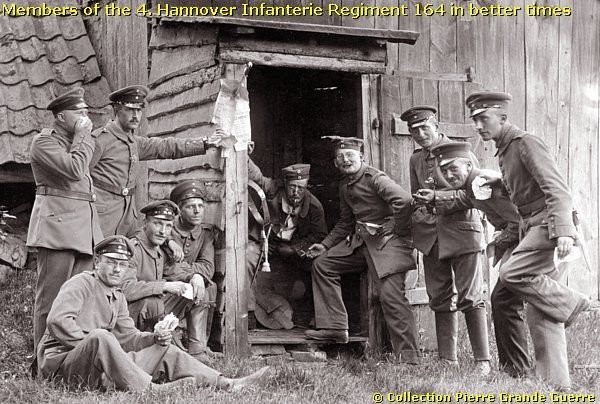
A silent witness of modern reconciliation, a British wreath of poppies, and a wreath of mixed flowers with a ribbon: “FRENCH-GERMAN FRIENDSHIP”.
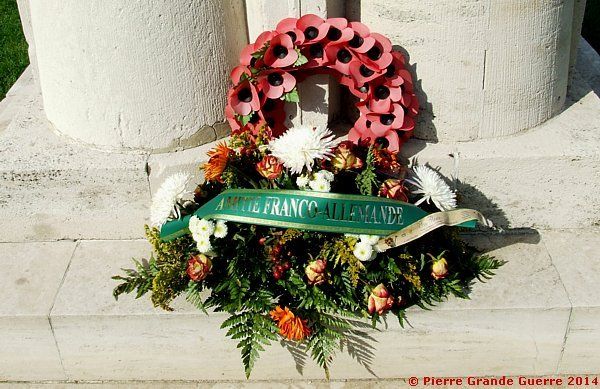
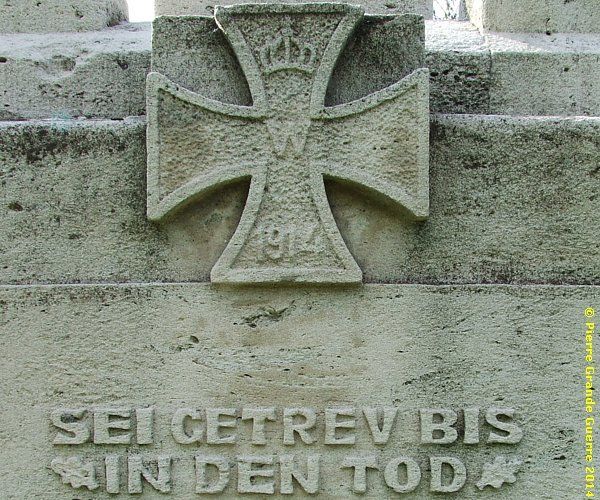
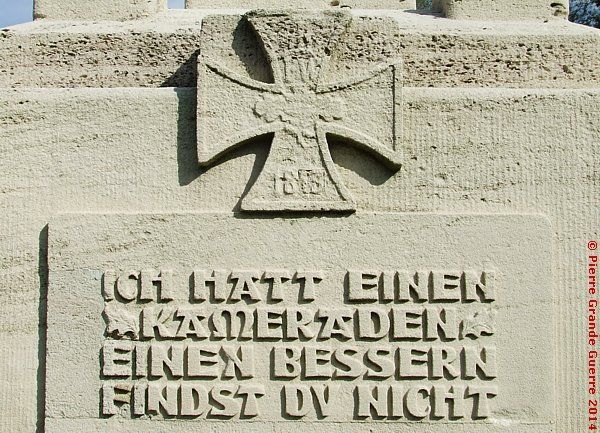
A last view over the vast cemetery.
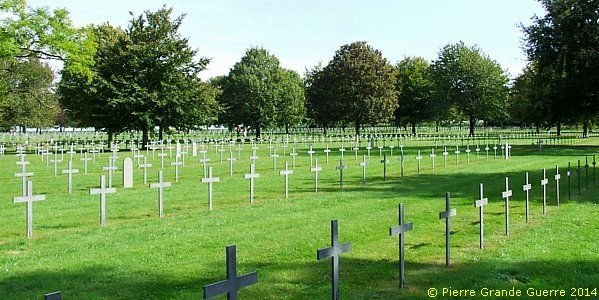
From the cemetery we turn around and follow the D 937 northward for a stop at the crossroads of la Targette.
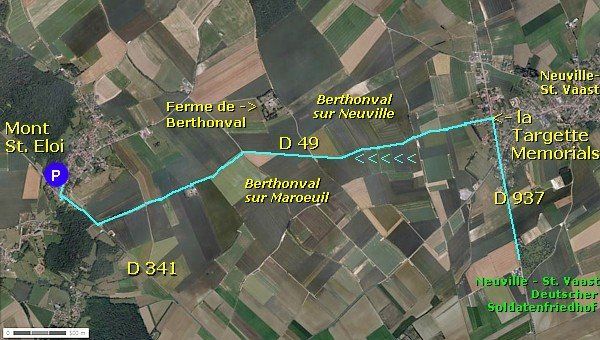
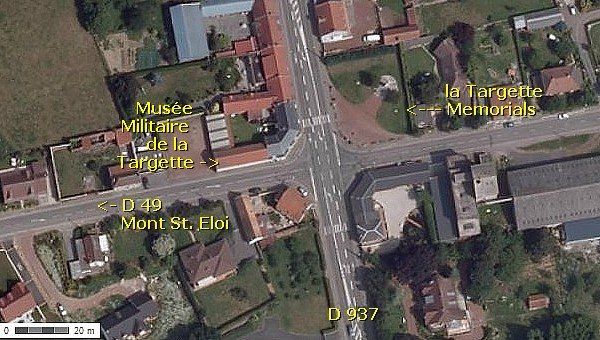
On the east side of the crossroads we find a modest park with three memorials. The largest memorial is called “ Le Flambeau de la Paix ”, the Torch of Peace.

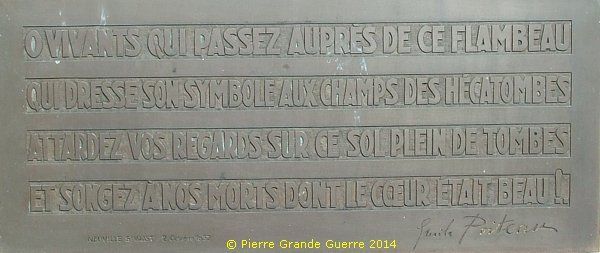
The second memorial honours Lieutenant Millevoy of the 74e R.I., ...
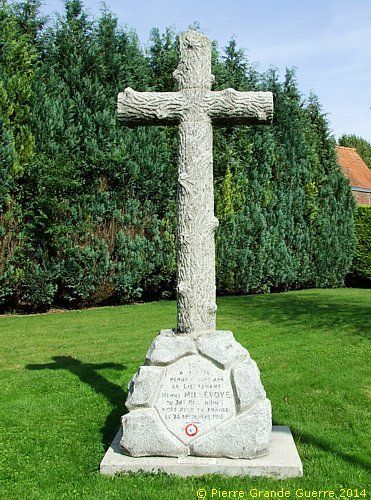
... who fell in the Neuville-St. Vaast front sector on the first day of the Third Battle of Artois, on 25 September 1915, during an attack on the "Plateau de Folie" and Folie Farm near Pétit Vimy.
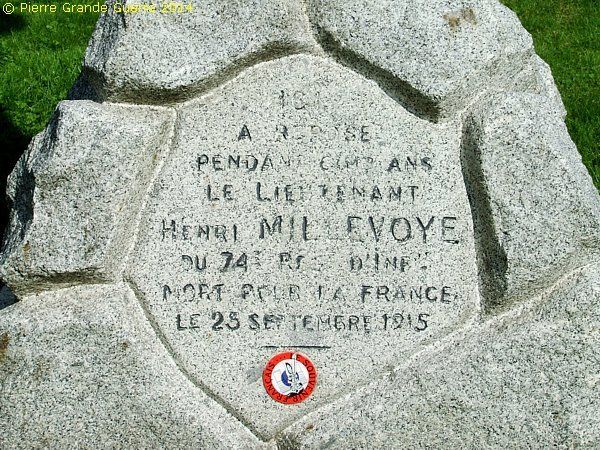
The Third Battle of Artois - 25 September – 4 November 1915
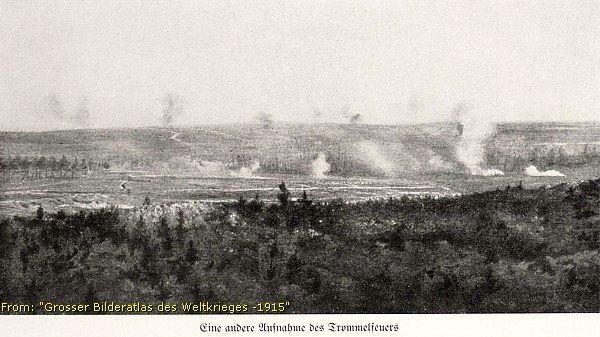
The Third Battle of Artois was meant to complement the Second Battle of Champagne , a last attempt by the French commander-in-chief Joffre to exploit the Allied numerical advantage over Germany before the next winter would come. Joffre's plan consisted of simultaneous offensives in Champagne-Ardenne and Artois, with the goal to capture German railways and supply centres and to force the Germans to withdraw.
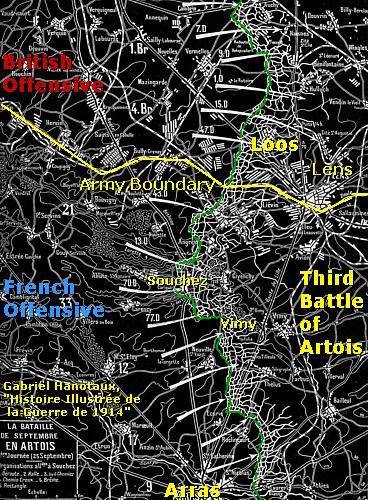
Joffre's plan to attack the Sixth Army of the Bavarian Kronprinz Rupprecht involved the British Expeditionary Force launching simultaneously the Battle of Loos . At first, Field Marshal French and General Haig were reluctant about such an offensive, invoking arguments like a lack of heavy artillery, ammunition and troop reserves. Pressure from the British Minister of War, Lord Kitchener, made French and Haig agree to Joffre’s plan and to a British military operation at Loos-en-Gohelle.
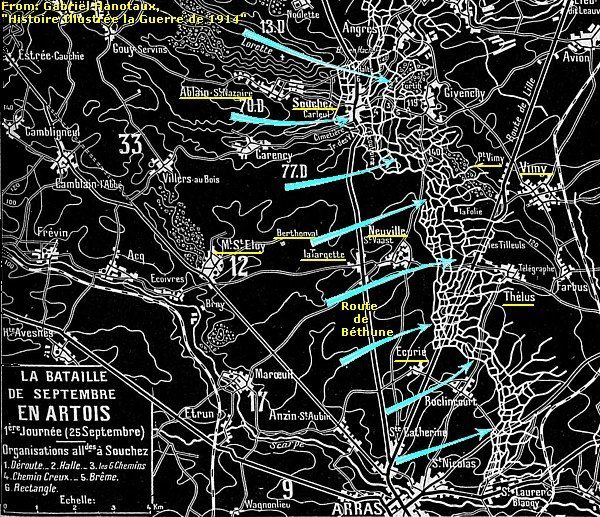
Following a four-day artillery bombardment starting on 21 September 1915, the French Tenth Army of Général d’Urbal initiated its advance on 25 September.
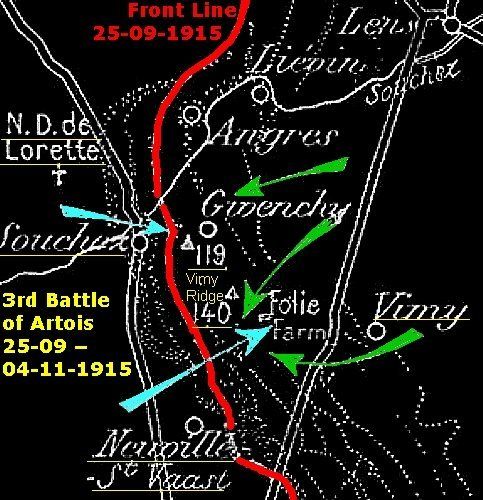
On 26 September the infantry of XXXIII and XXI Corps attacked and captured the village of Souchez. But suffering several severe German counter-attacks III and XII Corps had made little progress around Neuville-St. Vaast. The French failed to breach the German second line of defence and they did not achieve a breakthrough nor a forced withdrawal.
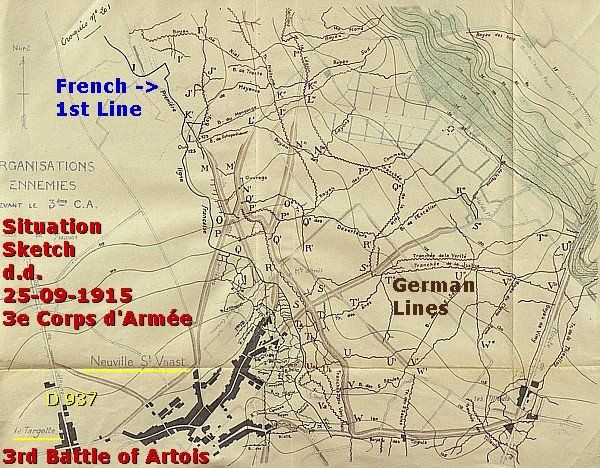
German historians of the “Reichsarchiv” recorded German casualties to the end of October as 51,100 men. Historians estimate the French casualties until 4 November to be 48,230 casualties.
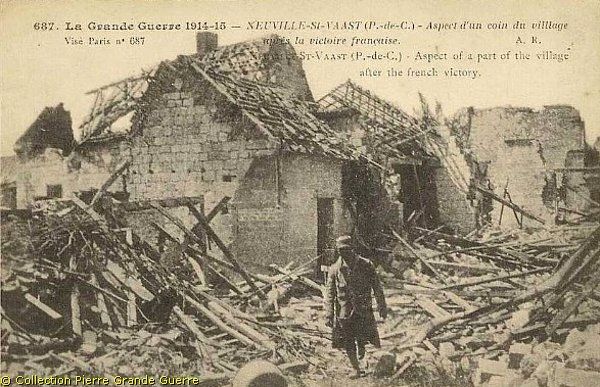
The third memorial is dedicated to 2nd Lieutenant Nouette-d’Andrezel of the 36e R.I., who was also killed on the 25th near Neuville-St. Vaast.
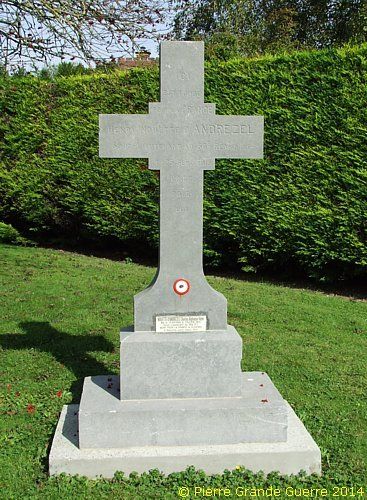
That day the 36e R.I. and the 274e R.I. were also involved in the attack at Folie Farm. Because of numerous German counter-attacks all three French regiments, involved in the Folie Farm attack, counted severe casualties, soldiers and an impressive number of officers.
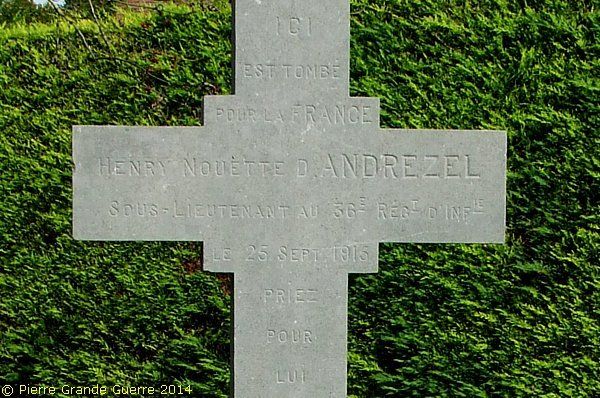
From the memorials at la Targette we pass the la Targette Military Museum opposite the park to continue westward via the D 49 to Mont St. Eloi.

On the northern side of the road were the jump-off lines of the 77e Division d’Infanterie with Berthonval Farm as its war-time headquarters. On the southern side of the road were the jump-off lines of the 53e and the Moroccan Division.
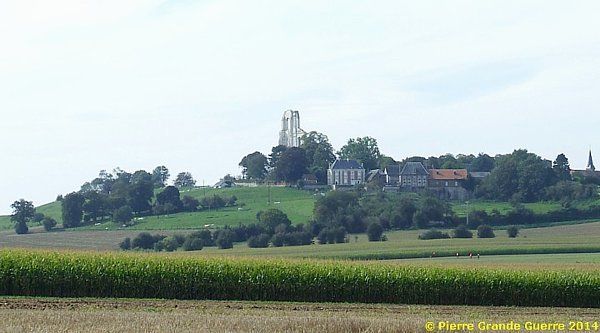
We visit the ruins of the Mont St. Eloi Abbey.
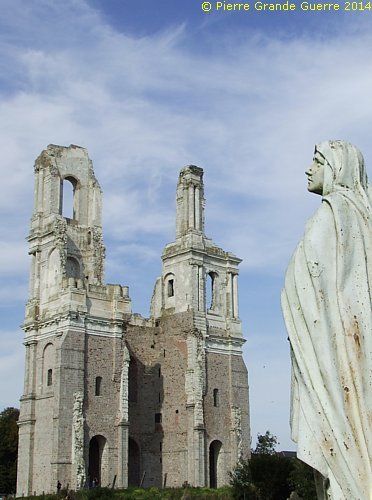
During the Great War the hill of Mont St. Eloi served to house French staff and artillery observation posts. Of course this fact was also known to the German artillery, which fired thousands of shells on the hill.
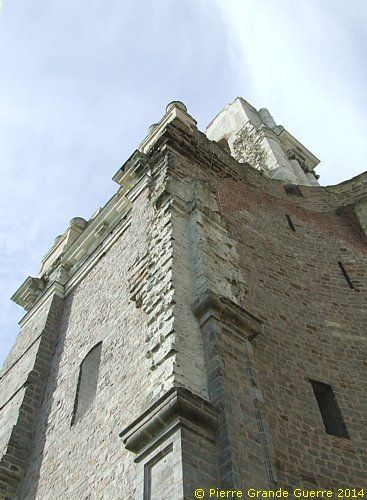
Mont St. Eloi Abbey

The ruins are originally from the 14th century abbey, partly destroyed during the French Revolution. Although the abbey ruins, and especially the towers, were at first more or less intact after the revolutionary damage, during the Great War German shells damaged further the towers and the rest of the main abbey building.
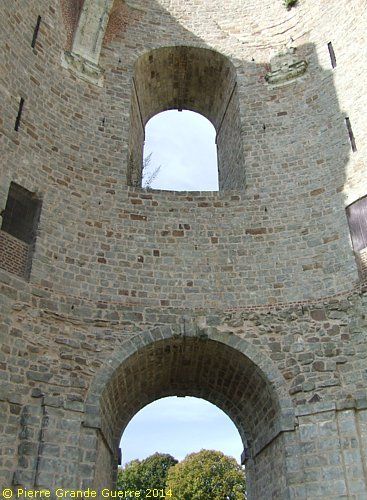
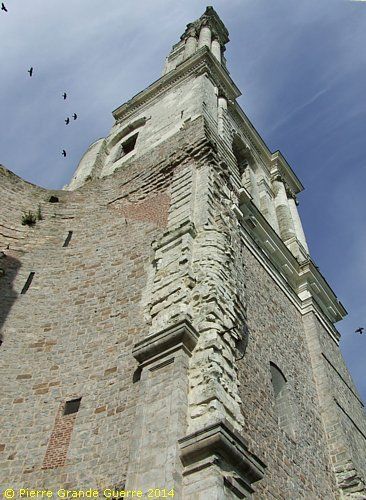
We finish our visit to Mont St. Eloi with a panorama north-east and eastward from the civilian cemetery near the ruins.
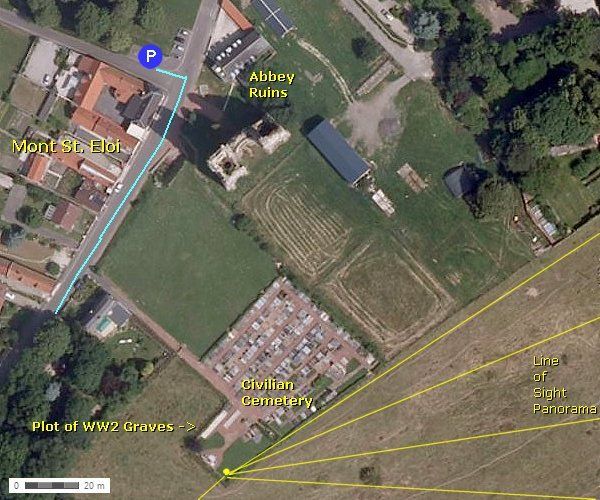

From left to right in 4 overlapping steps: views over the landscape of the former French jump-off lines.
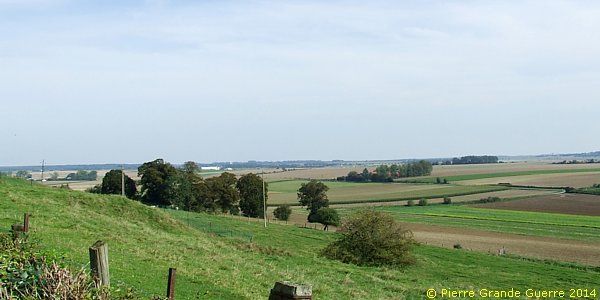
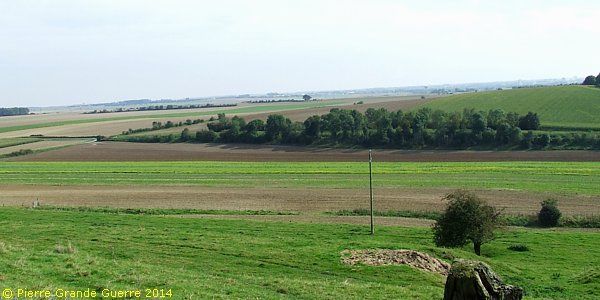
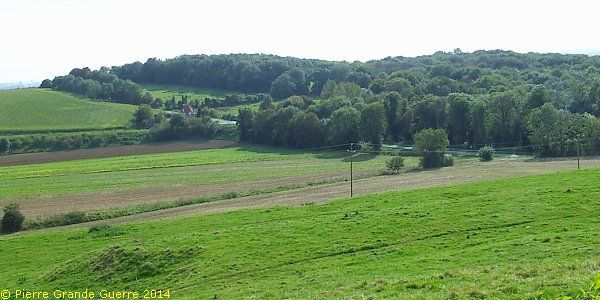
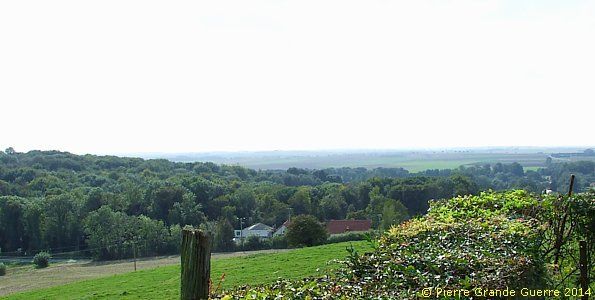
From Mont St. Eloi we return to la Targette to continue northward via the D 937.
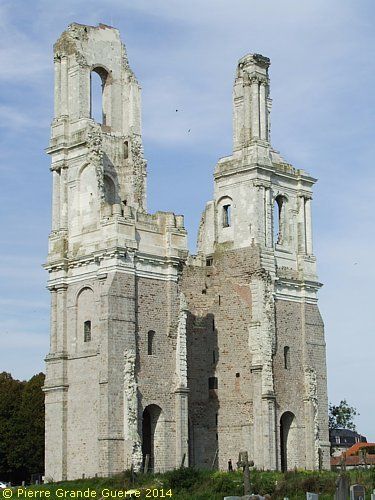
Some 2 km. north of La Targette we park our car to find on both sides of the road: a war memorial and a war cemetery.
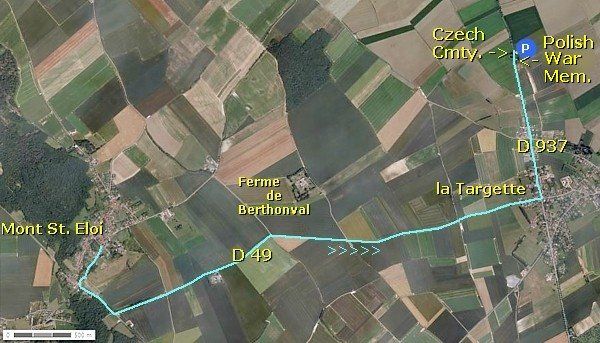
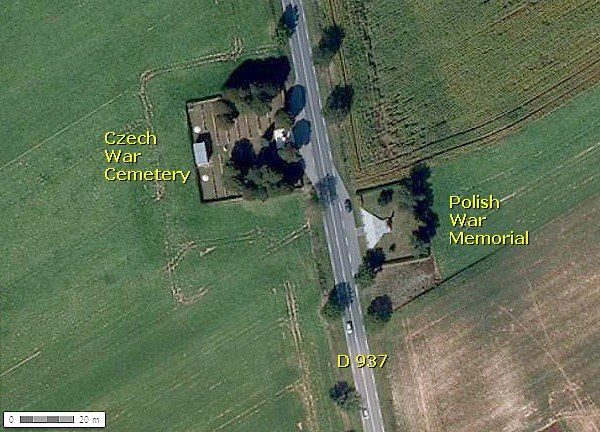
First we visit the Memorial for the Polish Volunteers , who fell on 9 May 1915 near this spot, in the area of la Targette and Neuville St. Vaast. The German positions were on the east side of the road.
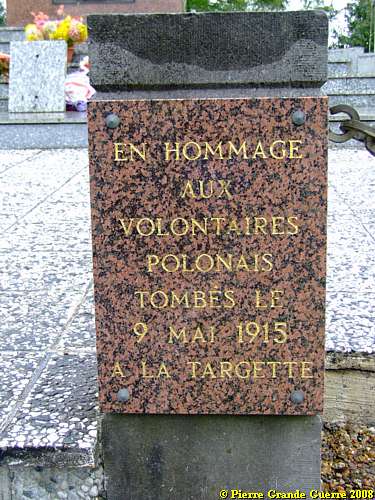
Motivated by the occupation of Galicia by the Russian Imperial Army, these Polish volunteered in 1914 for the Polish Legion, "Le Légion de Galicie".
They were also involved in the attack on 9 May at the German stronghold, Hill 140, Thélus Mill, at Vimy Ridge.
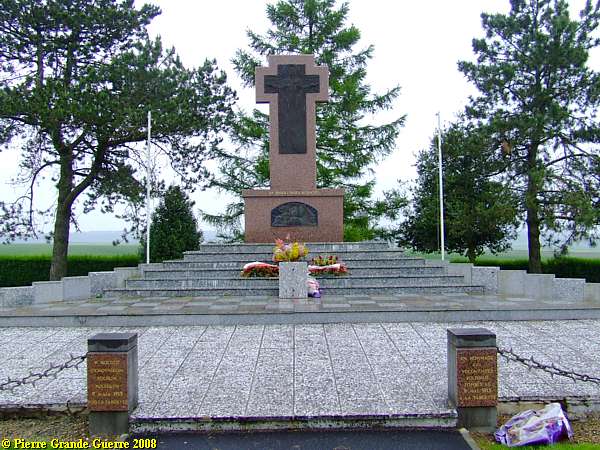
On the other side of the road we visit: the La Targette Czechoslovakian Military Cemetery .
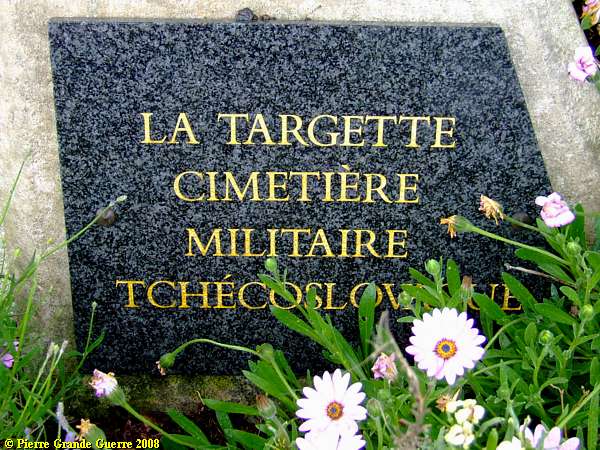
The
la Targette Czechoslovakian Military Cemetery
contains
the graves of 206 Czechoslovak soldiers: 70 soldiers of the Great War, and
136 soldiers of the Second World War, including 29 Airmen.
Source:
“ Mémoires de
Pierre
”
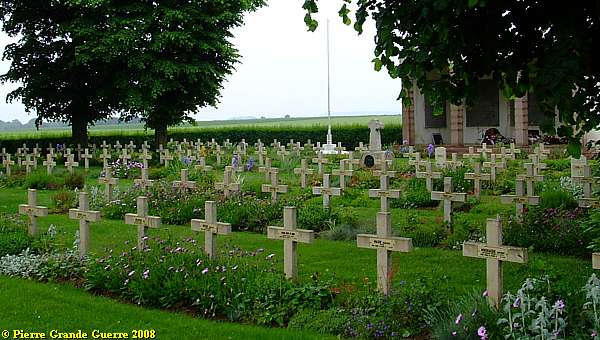
The Czechoslovakian Légions
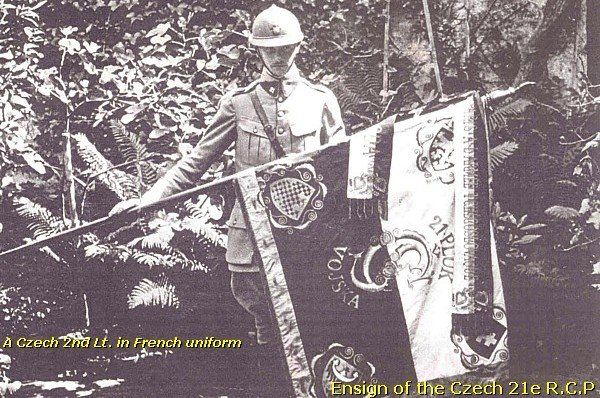
The Czechoslovakian soldiers, who are buried here, volunteered in the French Czechoslovakian Légions. These Czechs and Slovaks were inspired and motivated by their craving for their own Independence from Austria - Hungary. These Czechoslovakian Légions would finally grow into a force of 15.000 Czech volunteers, living in France and abroad.
The Nazdar Company
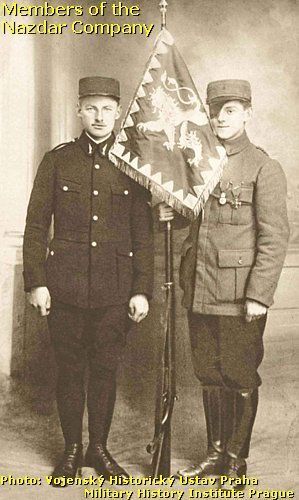
The first unit to fight under the French flag, was the Nazdar Company of 250 men, who enlisted already on 22 August 1914. The Nazdar company, originally named "Zdar", got its name from the original Czech greeting, "zdrobněle nazdárek", shortened in "Nazdar!". Nazdar developed to be a nationalistic equivalent of "Hello!"
On 9 May 1915, the Nazdar Company took part in the attack by the Moroccan Division at Vimy Ridge. The Company lost 50 men killed and 150 wounded out of a strength of 250.
In the Nazdar Company were two leading members of the "Sokol". The Sokol was a worldwide Czechoslovakian nationalist movement, members of which greeted one another with "Nazdar!" Among the fallen soldiers were the chief Instructor of the “Sokol of Paris”, Joseph Pultr, and the President of the “Paris Rovnost Socialist Association”, Josef Sibal.
The Czechoslovak National Council
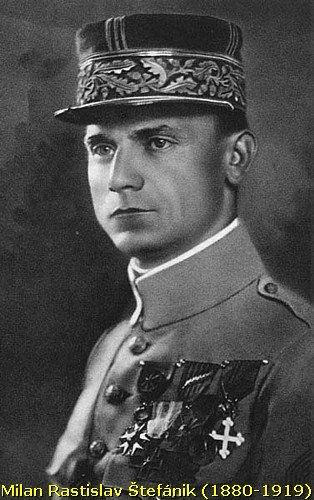
In February 1916 Milan Stefanik, a Czechoslovakian aviator in the French Army, Thomas Masaryk and Eduard Benesj founded in Paris the Czechoslovak National Council . They lobbied and pressed for the foundation of an independent Czechoslovak Army in France. On 19 December 1916 Président Poincaré issued a decree to organize an independent Czechoslovak Army.
On 29 June 1918 France recognized officially the Czechoslovak National Council as the first basis of the future Czechoslovak government. After the war Masaryk became the first President of the First Czechoslovak Republic. Later Benesj succeeded him as the second President. Stefanik became the first Minister of War of Czechoslovakia.
In 1918 an independent Czechoslovak Brigade was formed in France. The Brigade returned to its own country in the autumn of 1919. It counted 9,600 soldiers. Some 650 Czech and Slovak legionnaires perished in France during the Great War.
Source
a.o.: “
Czech Out
”,
Michael Cox & Dr Graham Watson: "Pour la France - A Guide to the
formations & units of French land forces 1914-18" and Rian van Meeteren
,
the Netherlands.

In the cemetery stands a Memorial with this French inscription:
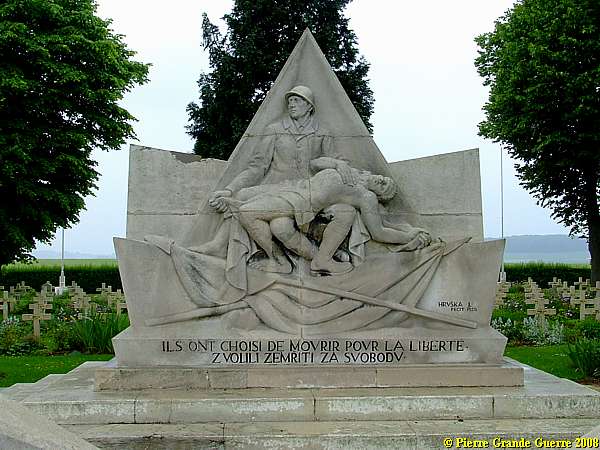
Karel Bezdicek

This monument is made by the sculptor Jaroslav Hrvska. The dying figure represents the legendary standard bearer of the "Nazdar Company", soldier Karel Bezdicek , originated from the town of Sezemice u Pardubic, who was killed on the first day of fighting. Karel Bezdicek fell, struck by a bullet in a German trench, his body wrapped in the Czech flag. He was remembered by his comrades as the first free Czech soldier to carry the standard of the Czech lion with the double tails.
Source a.o.: “ Czech Out ”
At the rear side of the Memorial:
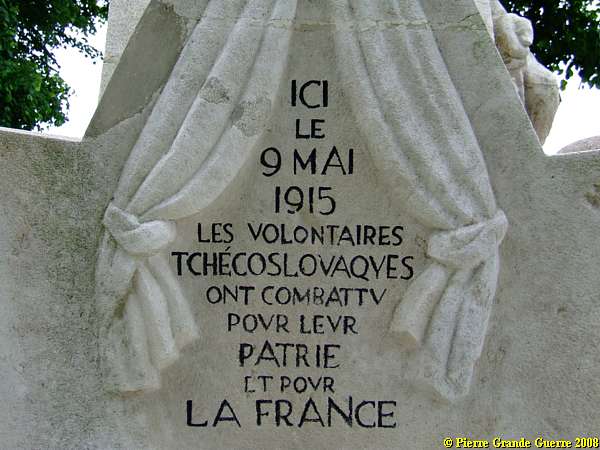
The same text in Czech and a list of names of soldiers without a known grave.
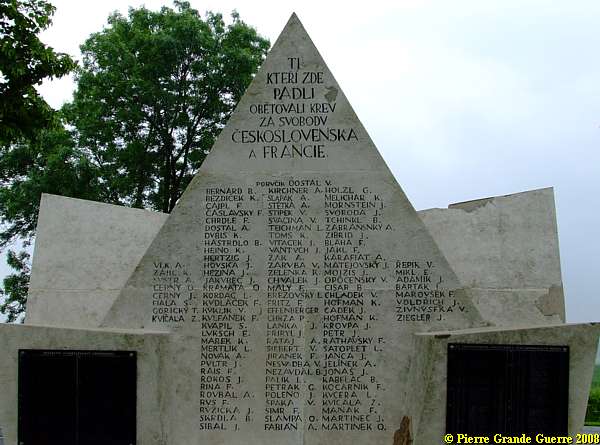
The Memorial commemorating the Nazdar Company.

From this area the Nazdar Company went over the top to find the first German trenches on the other side of the road. A plaque commemorates the Nazdar Company.
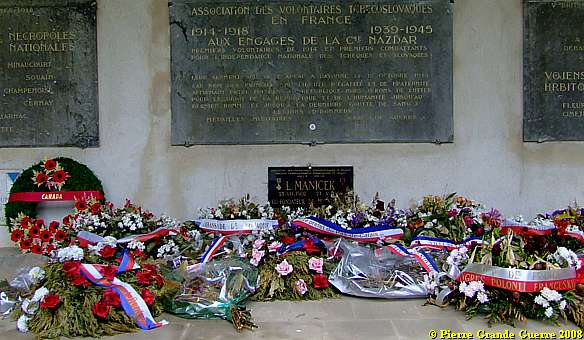
On their return the Czechoslovakian units had 80% casualties. Vimy Ridge would stay in German hands until April 1917.
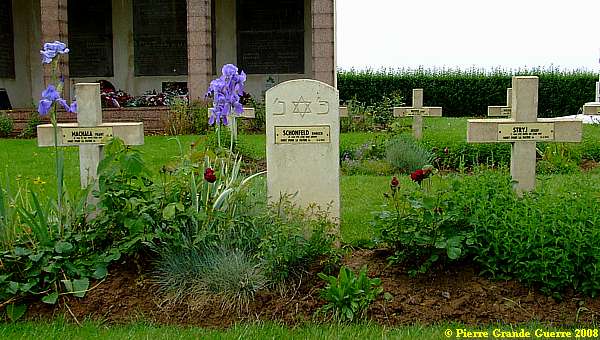
Some 2 km. more to the north, at the southern outskirts of Souchez, we visit the former location of the tavern of Le Cabaret Rouge.
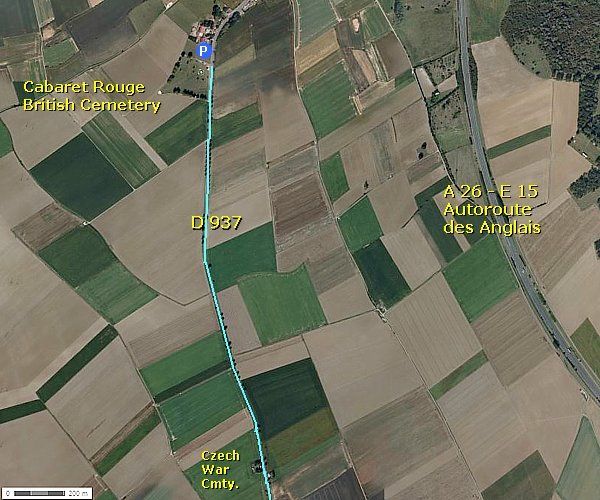
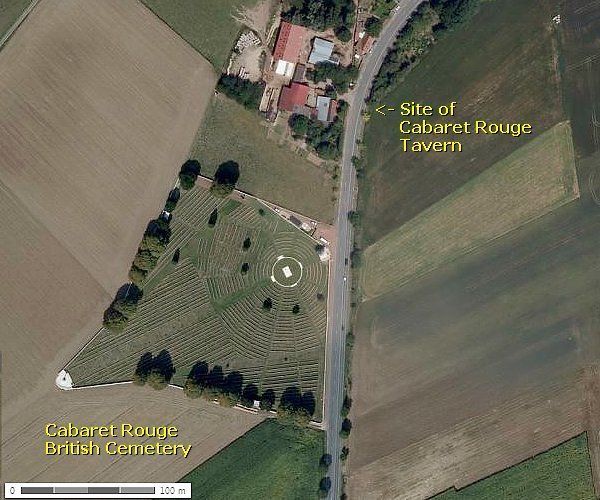
Only four flower boxes and a modest monument along the side of the road remind us of the site of this important landmark during the battles of Artois.
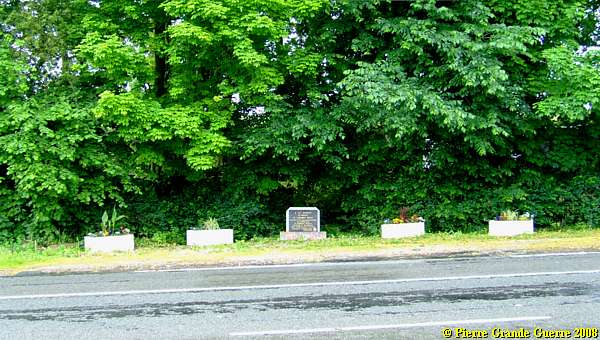
The Cabaret Rouge Tavern
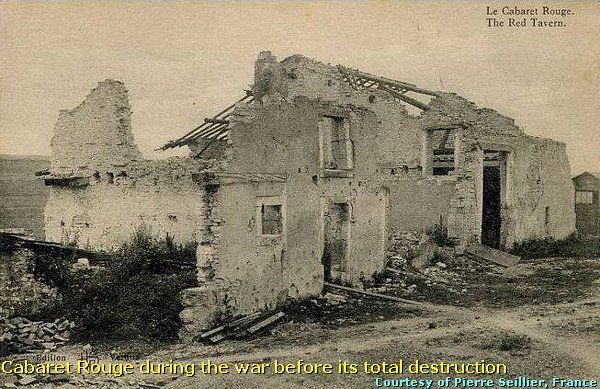
Le Cabaret Rouge, just outside Souchez, was a small tavern with red bricks and a red-tiled roof. Being an important landmark, it gave its name to this front sector and a communication trench. The café was destroyed by shelling in May 1915.
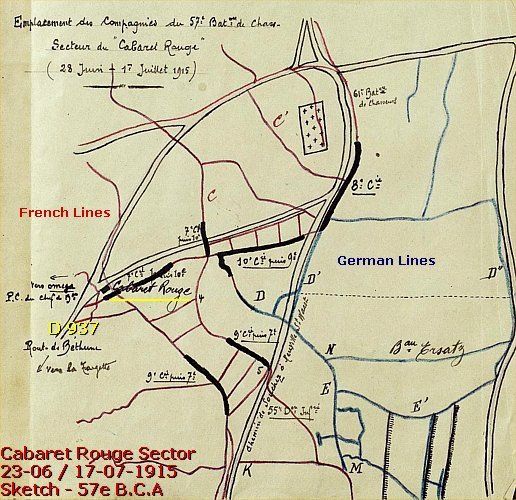

The tavern gave its name also to the Cabaret Rouge British Cemetery opposite the road.
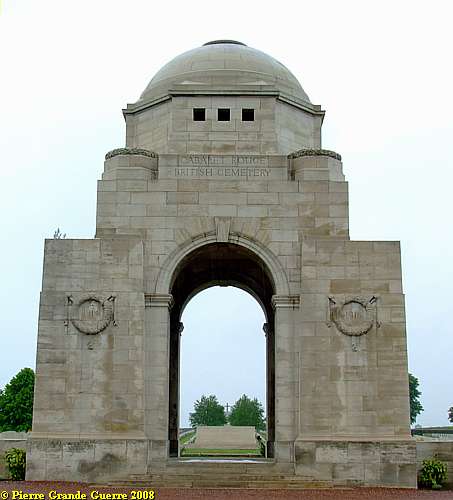
Cabaret Rouge British Cemetery - On 26 September 1915, Souchez was taken from the Germans by French troops, who handed the sector over to Commonwealth forces the following March. The Cemetery was begun by Commonwealth troops in March 1916, used until August 1917 (largely by the 47th (London) Division and the Canadian Corps) and - at intervals - until September 1918. It was greatly enlarged after the Armistice when more than 7.000 graves were brought in from the battlefields of Arras and from 103 other, smaller burial grounds in the Nord and the Pas-de-Calais. The cemetery now contains 7.655 Commonwealth burials of the First World War, more than half of them unidentified. There is also one Second World War burial. The Canadian, Frank Higginson, designed the cemetery.
Source : Commonwealth War Graves Commission
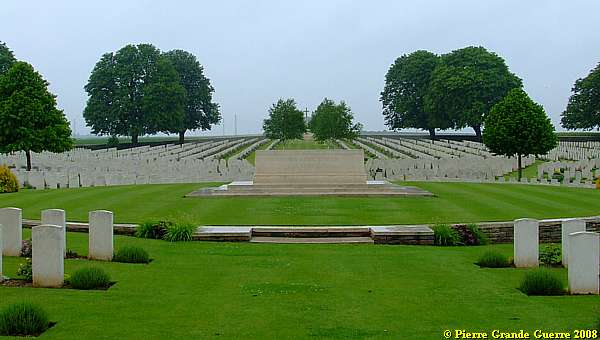
Soldier graves of many different units: Members of the Leicester Regiment, killed in 1915.
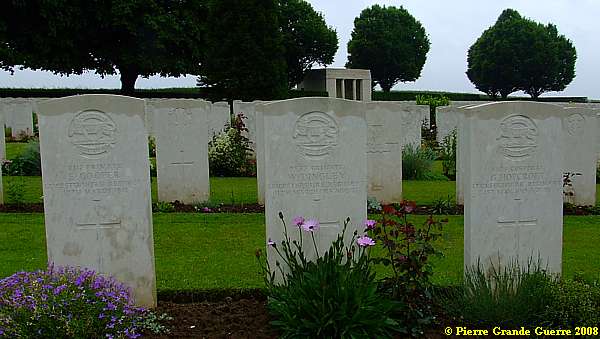
But also many graves of soldiers from Indian units: 10th Ghurka Rifles, the 84th Punjabis, ...
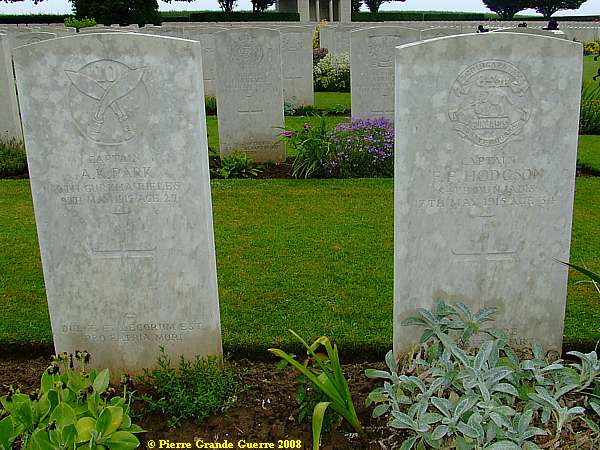
... 69th Punjabis, 4th P.A.V. Rajputs, ...
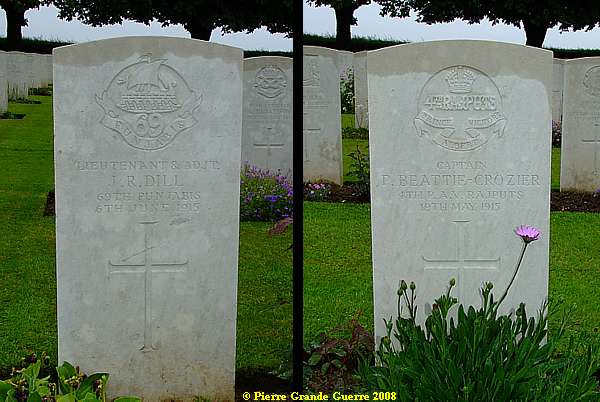
... and 15th Ludhiana Sikhs, killed in May 1915, during the Battle of Aubers Ridge.
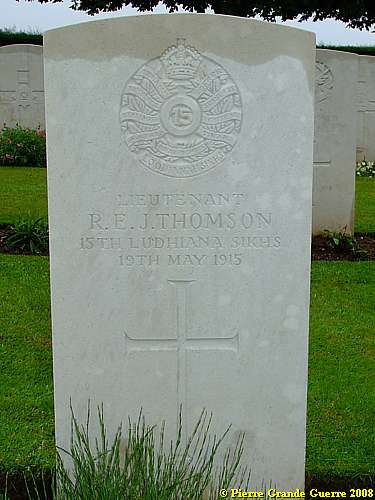
In this cemetery there are 3,500 Canadian graves ...
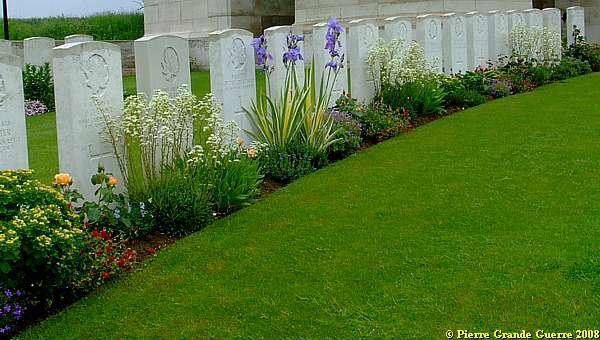
... mainly of the period of 9-12 April 1917, and the Battle of Vimy Ridge.
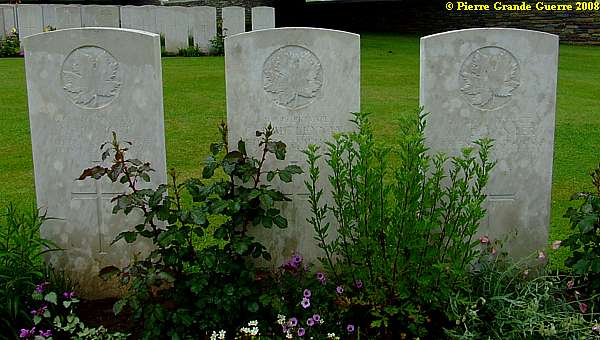
Or even a short time before.
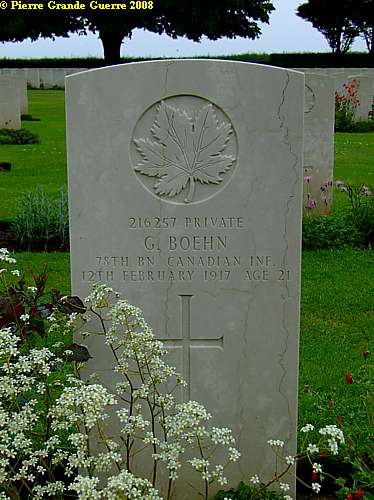
The Unknown Soldier of Canada
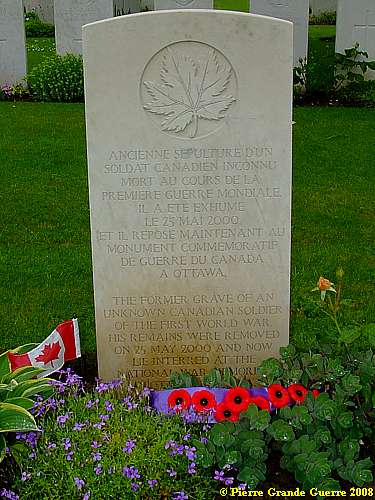
On 25 May 2000, the remains of an unidentified Canadian soldier were entrusted to Canada at a ceremony held at the Vimy Memorial, France.
The remains had been exhumed by staff of the Commonwealth War Graves Commission from Cabaret-Rouge British Cemetery, Souchez, Plot 8, Row E, Grave 7.
The remains were laid to rest within the Tomb of the Unknown Soldier, in a sarcophagus placed at the foot of the National War Memorial, Confederation Square, Ottawa, Canada.

I walk up to the Cross of Sacrifice to photograph the landscape southward.
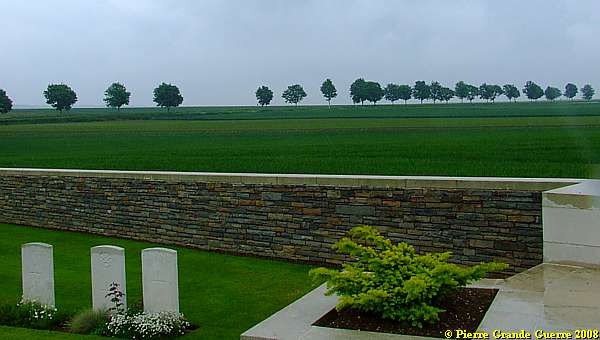
View over the fields northward to the hill of Notre Dame de Lorette, only 2,5 km. away from here.
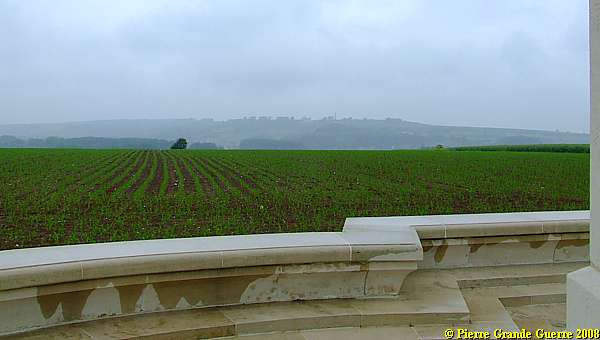
The rain is pouring down heavily now, but I could not resist this teleview.
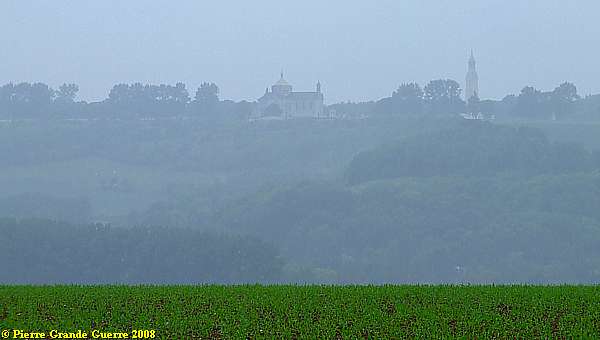
From the cemetery we continue northward along the D 937.
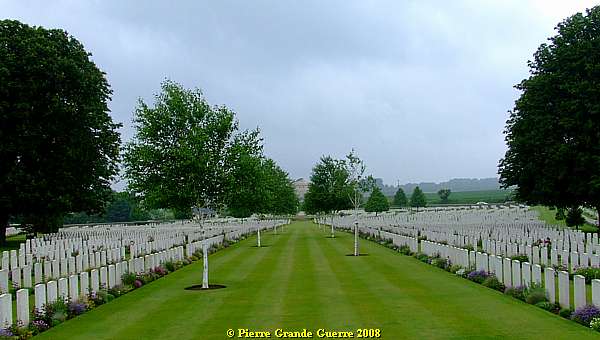
At the entrance of the town of Souchez we pass the large memorial for the soldiers fallen during the more recent wars in Algeria, Tunisia and Morocco.

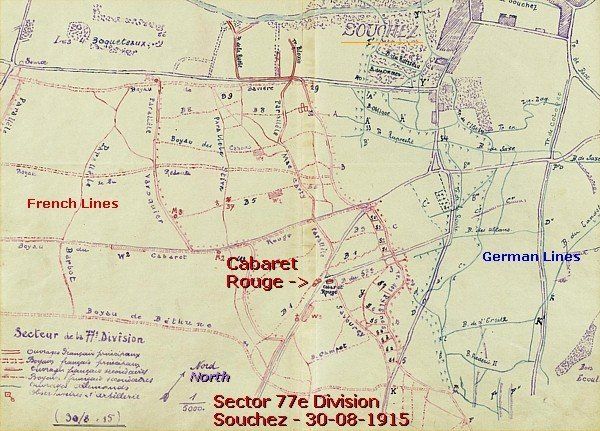
We stop at the memorial next to it: the memorial for Général Barbot and his 77e Division d’Infanterie .
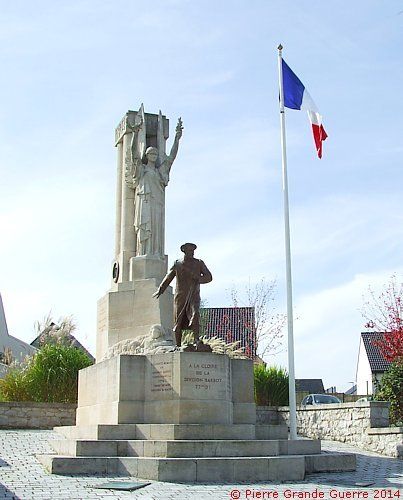
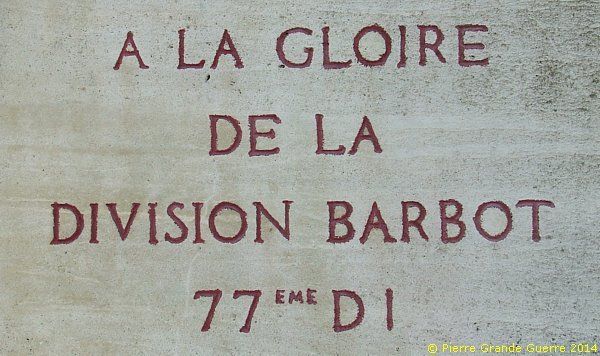
Besides 2 Companies of the Génie ( Engineers ) and the 6e Régiment d’Artillerie, the 77e D.I., consisted solely of alpine regiments and battalions!
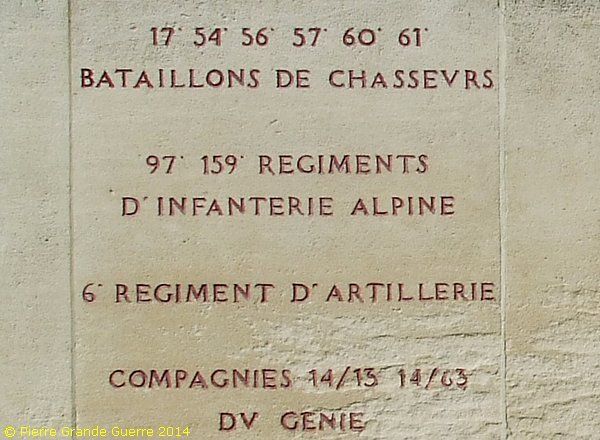
The 77e Division d'Infanterie

Although a large part of Souchez would finally be captured on 26 September 1915, during the first 7 days of the Second Battle of Artois, the 77e Division d’Infanterie of Général Barbot suffered severe losses.

From the jump-off lines at Berthonval the 77e Division d’Infanterie attacked on 9 May 1915 the sector of Cabaret Rouge, Souchez and Hill 119, north-east of Souchez.
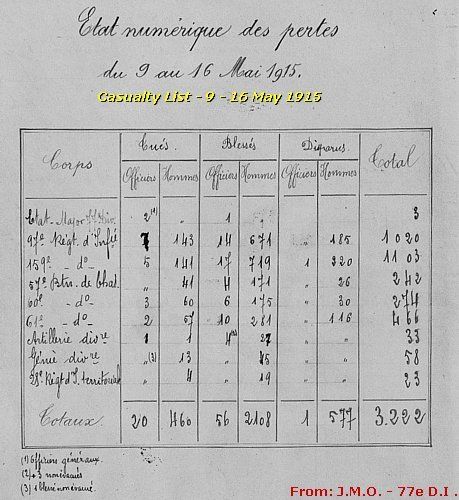
Especially during the first week of the offensive, 9 – 16 May 1915, the 77e Division d'Infanterie lost most of its men: 3,222 casualties!
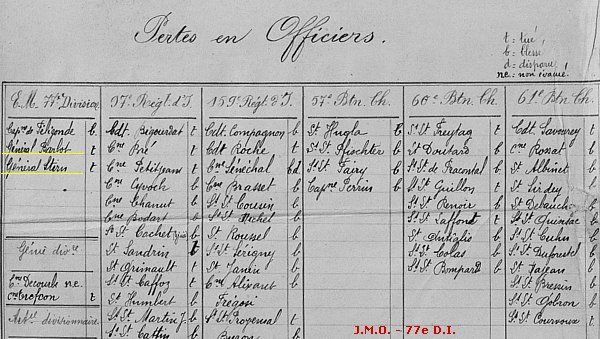
Within 48 hours the 77th Infantry Division lost even two Generals!
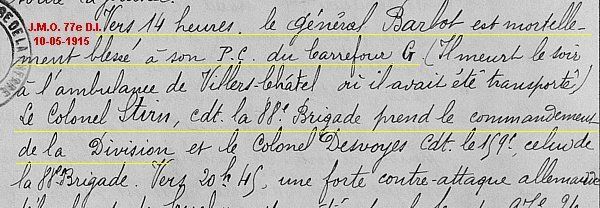
Général Barbot was severely wounded on 10 May 1915 around 14.00 hrs. in his command post at the crossroads "G", some 100 metres from the memorial site. Barbot died in the evening in the military hospital at Villers- Chatel.

On 12 May, around 14.00 hrs., his successor, Colonel Stirn, temporarily promoted to Général, fell by a direct hit on his Command Post in the Bois de Berthonval, south of Souchez. Général Delmotte took over the command of the division temporarily, until Général Pillot succeeded Général Stirn. During the Great War France lost 42 Generals on the battlefield.
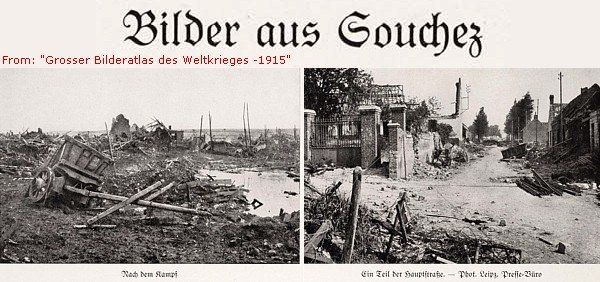
The statue represents a full size
image of Général Barbot, Commander of the 77e D.I.
Notice the coat of the statue; the closure of the trench coat is on the wrong side.
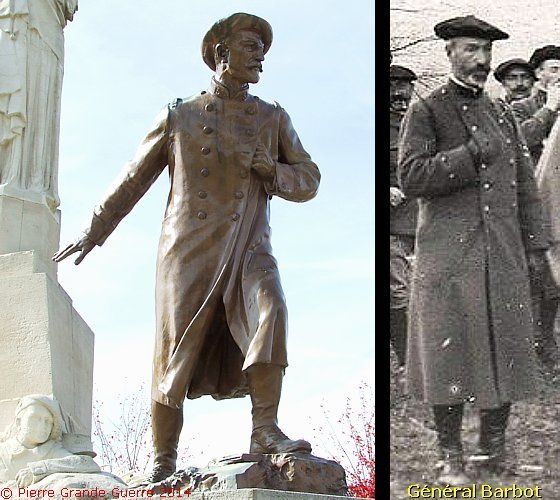
A bronze bas-relief on the memorial shows a portrait of Général Stirn.
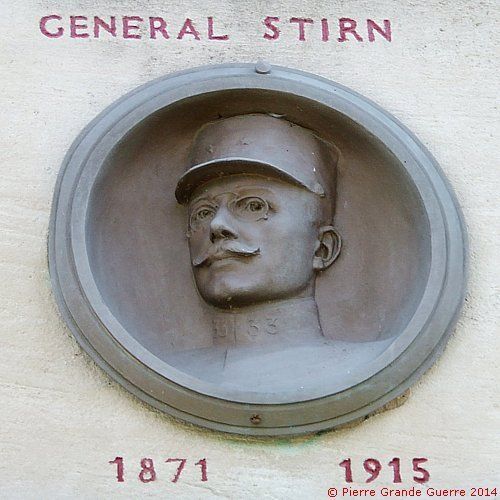
A list of battlefields, where the 77e D.I. fought during the war.

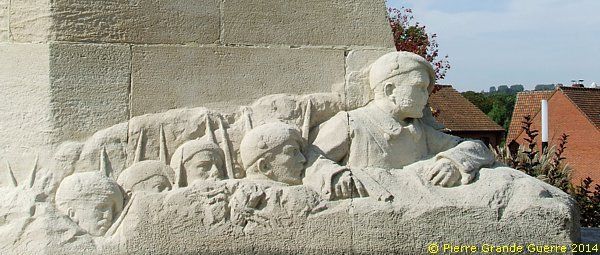
From the site a view northward at the hill of Notre Dame de Lorette, where Général Barbot is buried in the Notre Dame de Lorette Nécropole Nationale, …

… with its typical Basilica and Lantern Tower.
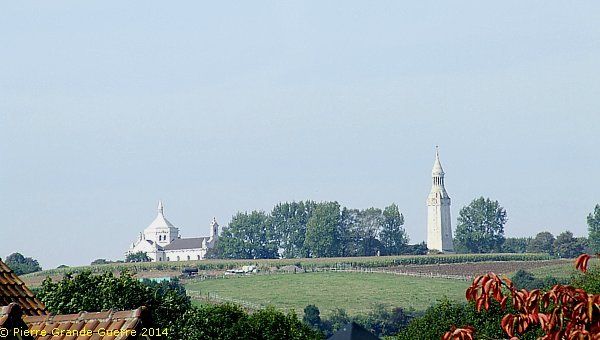
From the Barbot memorial we continue northward to the last site of our route.
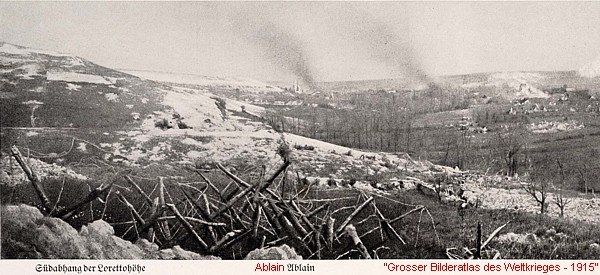
At the centre of Souchez we turn left to continue via the D 57 eastward to the centre of Ablain-St. Nazaire .
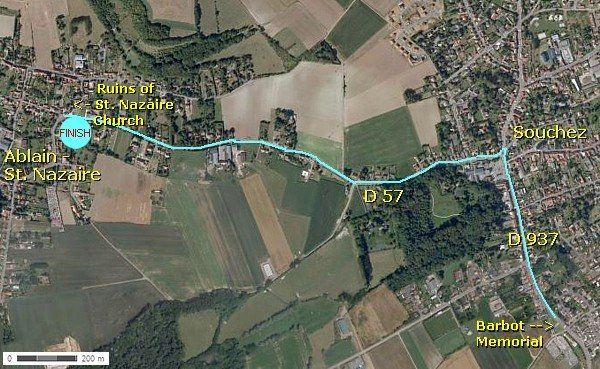

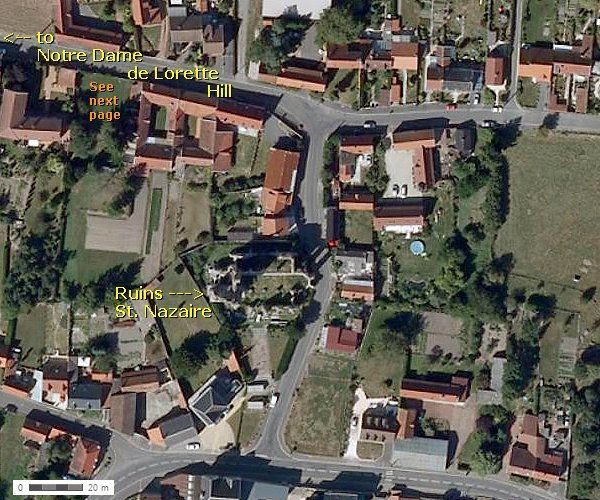
Here we visit the 1915 ruins of the St. Nazaire church, at the foot of the Notre Dame de Lorette Hill.
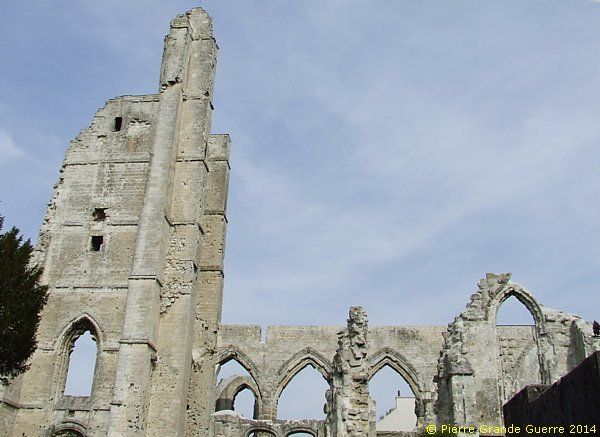
The former St. Nazaire church originated from the 15th century, but it was destroyed by German fire during the period October 1914 – October 1915.
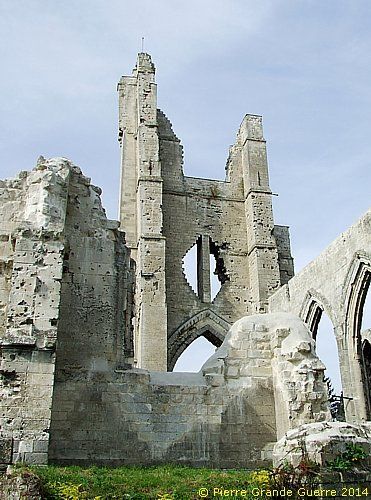
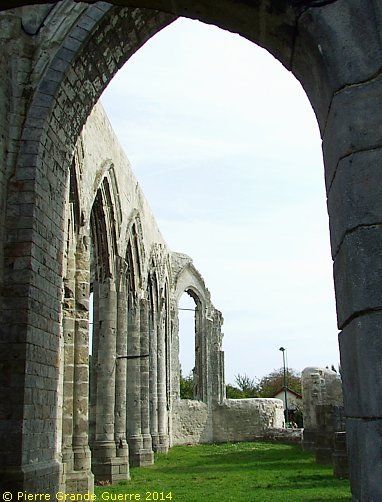
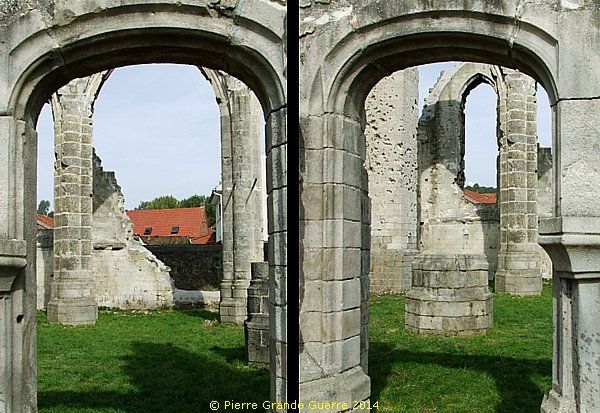
View from the ruins of the church of Ablain-St. Nazaire to the cupola of the Basilica on the Mont de Notre Dame de Lorette.
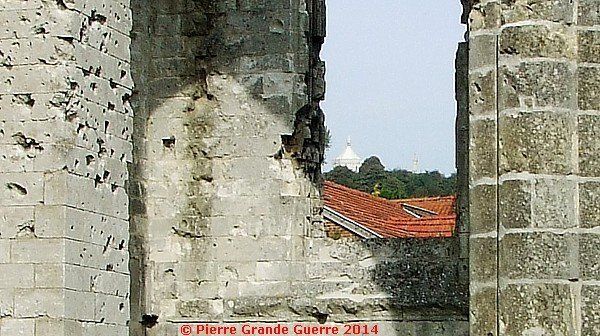
The scars of war are clearly visible.
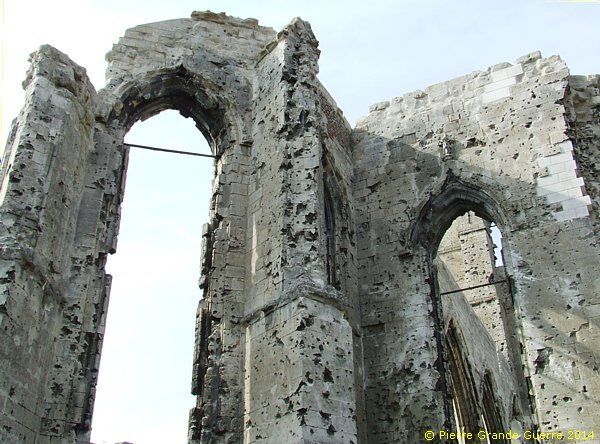
From Ablain-St. Nazaire we continue to the Hill of Notre Dame de Lorette on the next page.

Continue to the next chapter: " Notre Dame de Lorette ".










